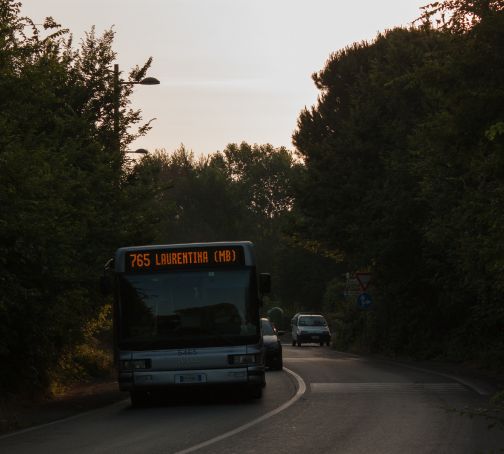Living along the Appia Antica can have its drawbacks but once inside The Compound, the rest of the world melts away.
People walk along the Appia Antica as tourists, soaking up step by step the layered history of the cobblestones, partaking in a pilgrimage along one of the first, most strategic roads of the ancient Roman republic. They peek through the high gates of the villas, wondering who lives in these great mansions with long, winding driveways, hidden behind pristine gardens and stone walls.
When I was given the chance to live on the inside of the gate, I knew how lucky I was. Far as it is from any metro stop, and not having a car, didn’t matter. There I became the neighbour of Valentino. I entered a world where phone calls to Gina Lollobrigida, a former sex symbol and high-profile actress of the 50s and 60s, are made twice a year: once on her birthday and once on New Year’s Eve, to explain that her grandiose fireworks are a fire-hazard to the garden and scare the ponies. She has the neighbouring garden, where she keeps peacocks that on summer days squawk you into thinking you’re in Sri Lanka. Some tourists ride a bike to see the Appia Antica; I lived there and took the bus.
There is a stop on the Metro A at Arco di Travertino. If you ever find yourself there, there’s a great kebab place called Ali Baba. It’s next to another kebab place that I would not recommend. There is also a newly renovated bus terminal that I watched go up over the year I spent waiting for the 765 to take me home to the Appia Antica. (Just to be clear, because I realise that in Rome a year might pass without the bus arriving, I didn’t spend a year waiting for one bus. I spent a year commuting to and from a villa called The Compound, owned by old family friends.)

You might ask yourself why someone, especially a 28-year-old from Los Angeles who works in the historic centre, who might be better living near a metro stop, would subject herself to this daily torture of public transportation. In a city notorious for strikes, and where a third, much-needed, metro line has taken 30 years to construct, relying on buses is shocking to a Roman. Going out at night takes planning. Talking people into picking you up often comes to no avail. The area is generally unknown to taxi drivers, and when you say it’s near the Appia Antica, a certain concern for their car tires spreads across their face. There is also the frustration of having to stand, squashed against a window, under the armpits of an entire tour group of French teenagers that gets on the bus at the catacombs. To your question I can only answer that The Compound is an oasis.
We all seek an escape, hoping it can be bought on an island in Greece or a week in Costa Rica. But the truth we are searching for, in stopping and slowing down, as it turns out, does not lie in a vacation home. For me, the escape I was searching for truly has shaped me. I found it hidden in the middle of a city, isolated ‒ everyone who lives there knows to stand next to a certain tree for mobile phone reception ‒ and connected to the outside world by only the one bus that would become my lifeline.
Once, when my sister was visiting, we spent a challenging day combating a public transport strike. On our journey home after a long day, we missed our stop at Arco di Travertino. We were on a bus I had never taken before, and I assumed, quite wrongly, that it would stop at our bus stop. My sister had even asked if we should ring the button. In my confidence, I said: “No, no someone will be there getting on, and it will stop.” As the bus zoomed past Arco di Travertino, we both panicked. Oh great, it’s an express! Next stop, Numidio Quadrato. In sciopero traffic. In my disdain, I insisted we walk home from Numidio Quadrato. No way was I getting on the metro to go back to Arco di Travertino just to wait for another bus that might never come. So we found ourselves, exhausted and with sore feet, racing along Via del Quadraro to get back before dark. We trudged in single file under the aqueducts at sunset. We marvelled at their size, the sun fading behind them. Where else in the world is that your walk home?

When you unlock the high green gate of The Compound, watched by the tired eyes of Romans stuck in rush-hour traffic, and hear the crunch of gravel under your shoes, the frustration from the beggars on the metro and the vibrations of the bad shocks on the bus melt away. The air is cooler and fresher than in the city. Your tired legs suddenly feel lighter, and you walk quickly to the house to see who is working on what project: upholstering furniture, making kitchen shelves, baking a crostata.
The Compound gleaned its name from the fact that many people live there, and many more come and go. There is the Ikebana master who tends the roses and fills the garden with beautiful sculptures made in her on-site ceramics studio. Her husband is a documentary film maker Their daughter, a few years older than me, works as an artist, and introduced me to a world in Rome I never would have found on my own, including Venanzio and the iPhone clinic. Her scuba-diving boyfriend, with a passion for building motorcycles, told me stories about breaking into the Colosseum at night. This family took me in, The Compound acting as a bridge between generations and cultures.
My father lived here too when he was my age. He came to Rome in 1984 after a car accident left him with a broken neck and a substantial pay-off from the insurance company. Seems reasonable that a 26-year-old would use that money to chase his Italian girlfriend, who had gone home to Rome for the summer. The girlfriend’s name was Mariella, a beautifully exotic name that for me evoked a tan-legged, long-maned woman with a thick accent. Mariella’s parents put him up in their apartment in Piazza Bologna, in a separate bedroom, obviously, since her father was a generale in the Italian air force. He filled his time attending Italian lessons taught by a nun, until Mariella decided she was going to Sardinia and not taking my father with her. He called the only Roman he had met, Mario, who said, “You can go to my friend’s on the Appia Antica.” So he got on the back of Mario’s Honda motorcycle. Balancing a guitar in one hand and his suitcase in the other, they made their way over the cobblestones that are the thing of taxi-driver nightmares, and landed on the Appia Antica.
Where, 25 years later, I would stand and wait for the 765. Willing it to arrive, tapping my foot, checking my phone, and then looking up as the rumble of its weight came around the curve.
My daily adventure into the Eternal City begins from this point: the bus transporting me from my oasis and hurling me into the beautiful chaos that is Rome. I still haven’t figured out the undignified scramble of getting on the bus, unwilling to throw elbows to push past those getting off. Nor is my seat-grabbing strategy quite up to par. But the 765 connects me to a family, to roots my father planted, to a new culture that I am lucky enough to experience on a deep level, to the magic of The Compound.
Caitlin Frost
This article was published in the July edition of Wanted in Rome magazine.



















